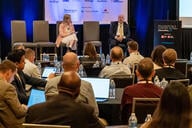You have /5 articles left.
Sign up for a free account or log in.
Trial and Error is a recurring feature from “Inside Digital Learning” that examines the successes and struggles of technology initiatives on campuses and in classrooms, on the assumption that we learn as much, if not more, from failure as from triumph. Have ideas for future columns? Send them to mark.lieberman@insidehighered.com. And be sure to comment below the story with thoughts and ideas for this institution.
The Institution: College of the Canyons, a two-year institution in Santa Clarita, Calif.
The Challenge: The institution’s leaders have been hoping to adopt open educational resources for the last decade. Three years ago, they felt the concept hadn’t yet gone mainstream enough to gather widespread support on campus -- even as more instructors were beginning to climb onboard, according to James Glapa-Grossklag, the college’s dean of educational technology, learning resources and distance learning.
“We were at a point at which we knew we were getting some traction with faculty,” Glapa-Grossklag said. “We could see the workload beginning to increase. We didn’t have the bandwidth in terms of time or tech skills in-house to do justice to the requests that we were getting from faculty to look for content.”
The Goal: Administrators thought getting a student involved behind the scenes of OER at the college might spur further growth. Through word of mouth, they heard about a student, Natalie Miller, who already had several jobs on campus: student services, student outreach and in the health center. They hired Miller without knowing exactly what they wanted her to do. She quickly took ownership of the position, and the college moved to expand the team to four.
The Experiment: Miller dove headfirst into the job -- unprompted, she started talking to individual professors, creating a brochure and sitting on the quad to promote OER to passing students.
“She really crafted what would become the duties of the position because she has so much gumption and self-initiative,” Glapa-Grossklag said. “I’d like to say that it was some master strategic vision, but the role and the duties of the position came from being fortunate enough to hire a really smart person.”
Instructors contact Miller’s team with specific requests for textbooks, and the team members do their best to start assembling the materials. A worker with some level of expertise in the subject matter takes the lead. The team reports to Brian Weston, director of distance and accelerated learning. The average workweek for each student worker is 20 hours. Pay is above minimum wage -- between $16.75 and $18.75 per hour.
“It’s very independent,” said Trudi Radtke, who attended the college from 2012 to 2014, earned a bachelor’s degree in history from the Master's College in 2016 and will begin pursuing a master’s in history this fall at California State University Northridge. “It is a lot of piecing bits of information together. Lots of communication between the professor and the OER assistant.”
Some textbooks take a month to complete, while more nuanced or complicated projects can take several months or even half a year, Radtke said. A set of resources for a class on water systems technology, for instance, was a longer-term project because it required “starting from zero” to create diagrams and Photoshop visualizations while synthesizing a high volume of complex technical terms.
Successes: Professors often don’t have time to find free web tools to create graphics or other multimedia for their course content. Tech-savvy student workers help fill that gap, according to Radtke. Those extra steps also make OER more appealing to outside observers.
“When you’re creating a free material, you don’t want ‘free’ to be immediately equated with ‘cheap,’” Radtke said. “You want the textbook to have an element of design, continuity.”
Faculty members often describe the initial search process for suitable course materials as “a drag.” Under this model, students complete that work for them, leaving the discipline-specific efforts to the subject-matter expert.
Students also serve as effective messengers for the OER philosophy, Glapa-Grossklag said.
“I’m a middle-aged white guy who’s got the title of a dean,” Glapa-Grossklag said. “I’m not as credible and convincing about the need to update your content and reduce the cost barriers of textbooks as a student is.”
Similarly, students and recent graduates have more insight into how their peers think. The student team can "write [quiz questions] in a manner where the question is still being answered to satisfy the understanding of knowledge, but written in a way to where the students know what is being asked of them," said Glapa-Grossklag.
Beyond the skills they’re acquiring, Glapa-Grossklag also hopes student workers come away with a better sense of how the institution operates and whom it hopes to serve.
Challenges: The student team experiences consistent turnover as students graduate and move away from the institution, according to Weston. Those built-in deadlines force the team to be creative about scheduling projects and ensure that professors have a “baseline of support” from a team even when multiple students are working on their textbook, he said.
Students sometimes come into the team with loftier expectations for their involvement in the projects than what they end up doing, according to Weston. He welcomes their eagerness but works to keep them within their role.
“We have to remind them that our faculty are the experts,” Weston said. “Students are here to help them infuse and give ideas, not to write.”
What’s Next: Weston hopes to expand the team to foster more student involvement in OER efforts. He also hopes to see the institution formalize its commitment to OER and affordable publishing, perhaps persuaded by a coalition of students.
“It’d be more of a grassroots effort on the student campaign part to help continue to support OER in the future,” Weston said.




